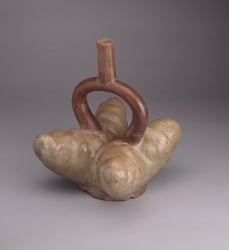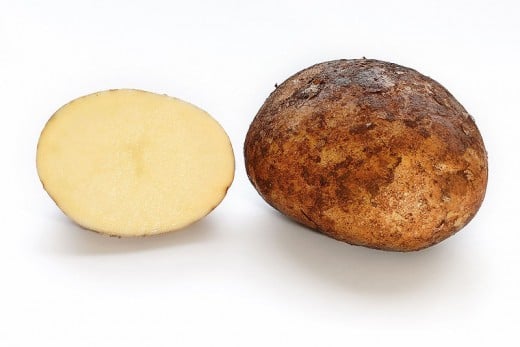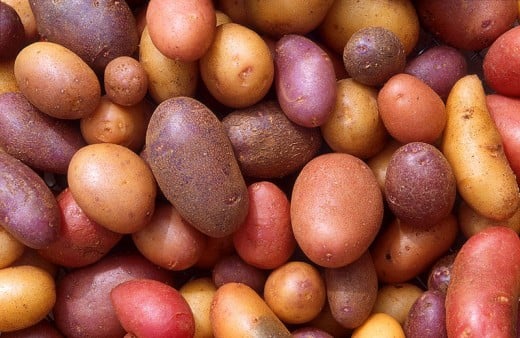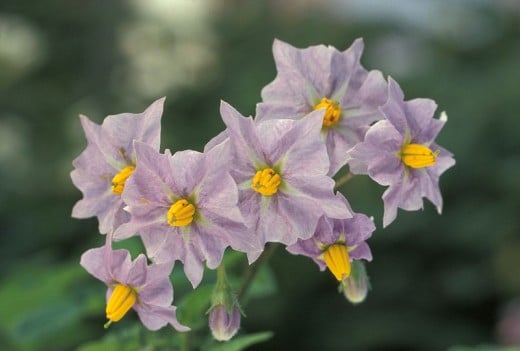What are the Benefits of Potato
Where did the Potato Originate
Potatoes are thought to have originated in southern Peru home to close to 4,000 varieties. This may sound strange, but the natives of Peru have long known that a blight that affects one or more varieties of potato will skip or pass over others. By growing so many different cultivars ancient Peruvians were assured of a steady food crop. Agriculturists and scientists alike are now seriously studying this biodiversity as a means of ensuring a hardy food supply.
Despite this basic source most of the 'commercial' potatoes grown today can trace their ancestry back to a variety grown in the Chiloé Archipelago where it was cultivated as long as 10,000 years ago.
In 1536 the potato made it's way to Spain and rapidly spread to the rest of Europe, primarily in Mediterranean climates.
As more cultivars from the Americas were introduced and the plants themselves were cultivated for certain traits, the potato spread north to the British Isle and Ireland. Despite this spread (a hardier potato being introduced in the north) the variety was still quite small and a fungus born blight (thought to have wafted on the air from a ship in port) in 1845 spread rapidly through the poorer communities of western Ireland. This resulted in the widespread failures that led to the Great Irish Famine.
The word "potato" is derived the Andean word papa which was actually used for a sweet potato. Though the two plants are not related the English confused the two. In later years an herbalist John Gerard used the term "Virginia Potato" to distinguish the white potato from the red/orange sweet potato.
Since the potato and tomato are members of the nightshade family both produce fruit resembling the tomato berry; however, the potato berry is toxic and should not be consumed.
Potato plants do produce seed from these berries, but can also be grown from tuber cuttings that include at least two eyes. Only commercial potatoes do not produce seeds and all are grown from the (misnomer) seed tuber.



Potato as Topical Cosmetic
Potatoes contain a surprising number of nutrients and vitamins. These include the vitamins B1, B2, B3 and B6 as well as vitamin C. Potatoes also contain calcium, iron, magnesium, phosphorus, and potassium.
Maltodextrin, extracted from the potato, is a common cosmetic ingredient because it helps bind other ingredients in makeup together. Lately maltodextrin has been found to enhance the effects of the anti-aging activity of hydroxy acids. Glycoproteins are also extracted from potatoes to enhance skin repair and can be found in certain wrinkle prevention preparations.
Potato starch is finding its way into sunscreens because it has similar properties to minerals such as talc, mica, zinc, and titanium dioxide. Unlike these four potato starch will not deactivate the other ingredients in sunblock. Also, unlike talc, it will not block pores, irritate the skin, or pose a cancer risk. Potato starch is also a good "blotting" agent which provides a hypoallergenic matting or cosmetic base. Since the starch also does not block pores it is easy to remove and better for the skin than mineral agents.
Potato juice has been found to be a good acne treatment as well with astringent properties.

Non Food Uses of Potato
Industrial Uses
The humble potato is used in industry to produce pure alcohol. Pure potato juice is also used to clean silks, cotton, and woolen fabrics.
Potato starch can (and has been) used as a plastic substitute for the manufacture of disposable plates and flatware. It can also be used as a stabilizer and filler in the manufacture of paper. Certain wood adhesive use potato starch as part of the formulation.
A New Brunswick (Canada) study estimated that the 44,000 tons of potato waste produced could be used to ferment up to four and a half million liters of fuel grade ethanol.
Home Uses
The water left over from boiling potatoes can be used to clean silver-ware. This "potato water" can also be used to help restore a shine to wooden furniture as a polishing agent.
Potato as Food
Animal Feed
When first introduced to Europe the primary use of the lowly potato was as animal feed. To this day roughly 50% of the potato harvest in the Russian Federation goes to the feeding of live-stock.
Cattle can be fed up to 40 lbs (20kg) of raw potatoes a day and pigs can consume up to 12 lbs (6kg) of boiled potatoes a day.
Human Food Uses
This may seem like a silly addition to this hub. Anyone reading this article is familiar with the potato and it's many culinary uses. But, contrary to common-sense, not all of the attributes of the humble potato have been fully explored.
The most common consumption of the potato is one that is cooked. Fried, baked, boiled, or even roasted, potatoes are a common food item in most households. Potatoes can be eaten raw however.
Caution: Never eat a green potato!
The green tint sometimes found in potatoes is linked to the production of glycoalkaloids. Glycoalkaloids are toxic and can cause headaches, diarrhea, stomach cramps, and in rare cases death. Exposing the tuber to sunlight can cause these toxins to be produced which is why potatoes should always be stored in dark cool places.
Less than Usual Recipes
The potato has been "done to death" as food, so these recipes are the less than usual found in most cookbooks and food preparation sites.
Baked Potato Pancakes (Latkes)
Ingredients
- One Cup of mashed potatoes
- 1/2 teaspoonful of salt
- 1 teaspoon baking powder
- 1 Tablespoon of flour
- 1 small onion, diced
- 1 egg beaten
- 1/4 Cup of milk
Directions
- Preheat your oven to 425° F
- Mix the dry ingredients (flour, salt, and baking powder) together
- Add the mashed potatoes and diced onions
- Mix in the beaten egg and milk. Blend thoroughly
- Prepare a cookie sheet with a light coating of oil or non-stick spray
- Beat once more and dollop 2 or 3 Tablespoons of the mixture about an inch apart
- Bake for 10 to 15 minutes, turn the cakes and bake for an additional 10 minutes
- Remove to a paper-towel. To keep warm place in a 200° F oven or toaster oven
Irish Potato Puffs
Ingredients
- 1 Cup mashed potatoes
- 1/2 Cup flour
- 1 teaspoon baking powder
- 2 eggs
Directions
- Put a large sauce pan of frying oil on the burner. Bring the temperature up to 350° F
- Separate the eggs and beat the yolks in a medium bowl until creamy
- Add the mashed
potatoes and mix thoroughly
- Sift together the baking powder and flour and add to potatoes
- Beat the egg whites till stiff and fold into mixture
- Drop a teaspoon of the mixture into the hot oil and fry until a delicate brown
- Drain on paper-towel and serve hot
Fried Potato Skins
This is so simple the only directions follow with no numbering.
Peel a number of potatoes with a knife rather than peeler. Drop the skins into cold water as you are doing this to prevent oxidation (browning). Prepare for deep frying with a large sauce pan with frying oil preheated to 350° F. Remove the skins from the water and pat dry. Drop the skins into the now hot oil and cook until the flesh (not skin) turns a golden brown.
Remove to paper-towels and salt & pepper to taste.
This is actually a "better for you" alternative to french fried potatoes since the skin of the potato contains most of the vitamins mentioned above. Also, the skin provides a crunchy counter-point to the crisp cooked flesh.
Flavor Boost
Potato does not have much flavor by itself, in fact it is often described as neutral. For an added boost to your next batch of mashed potatoes try adding a 1/4 teaspoon of nutmeg. This may sound odd, but the tiny amount of nutmeg adds an amazing amount of flavor to this dish.











